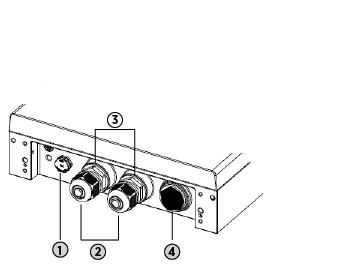Installation Do's and Don'ts
Learn about various do's and don'ts for each installation option before installing the access point.
The following diagram shows the AP5050D gland body components. Be familiar with each component before you install the access point.
AP5050D Gland Body

| Callout | Description |
|---|---|
| 1 | Vent - do not loosen the vent. Note: Do NOT remove
the vent or it's protective cap.
|
| 2 | Gland cap hex - remove only as needed to attach a LAN cable. Tighten to 12 inch-lbs |
| 3 | Gland body hex Note: Do
not loosen or unscrew the gland body hex.
|
| 4 | Console cap hex - retighten to 15 in-lbs. |
Installation Don'ts
Keep the following items in mind as you install your access point.
- Do NOT install the access point side with the user input/output facing upward or angled upward, toward the sky.
- Do NOT install the access point or open the console cap when precipitation is falling or is about to fall.
- Do NOT remove the gland
body. If the gland body is accidently loosened, it must be torqued immediately
to 30 in-lbs.

Important
The gland body keeps water from entering the access point.
Note
The access point ships with two black gaskets in the box for use with Category 6 (CAT 6) Ethernet cables with a cable diameter from 6.0mm to 9.2mm. This includes shielded and unshielded twisted-pair (UTP) Cat 6 and 6A cables. Store these gaskets in a safe place if you do not use them right away.The access point has light-gray gaskets pre-installed in the access point glands. The light-gray gasket handles all CAT 5 and CAT 5E cables, with a cable diameter range from 4.5mm to 6.0mm.
- Do NOT let moisture, dirt, pollen, or any other debris enter the glands or the console.
- Do NOT get a pressure washer nozzle closer than 24 inches to the glands, console cap, or vent.
Installation Do's:
Orientation:
- The access point can be mounted in almost any orientation.

Note
The only mounting orientation restriction is with the access point glands. The best practice is to have the glands on the downward side to maximize water draining away from the glands. - The side with the glands can be horizontal, facing down (ideal position), or anything in-between.
User I/O:
- Only the gland caps must be removed to install the ETH0 or ETH1 LAN RJ45 cable. Torque the gland caps to 12 in-lbs.
- The LAN cables must have a minimum radius of 1-in. and a 3-in. minimum drip loop. The drip loop allows gravity to carry moisture away from the glands.
- The console cap must be removed to install the console LAN RJ45 cable. Torque the console cap to 15 in-lbs.
- If used, torque the ground screw to a minimum of 12 in-lbs.
Power or Pressure Washers:
- The best practice is to keep a minimum distance of 24 inches between the pressure washer nozzle and the access point.
- Ensure that the maximum water pressure does not exceed 4000 psi.
- Fifteen degrees (15 degrees) is the narrowest nozzle that can be used for pressure washing.

